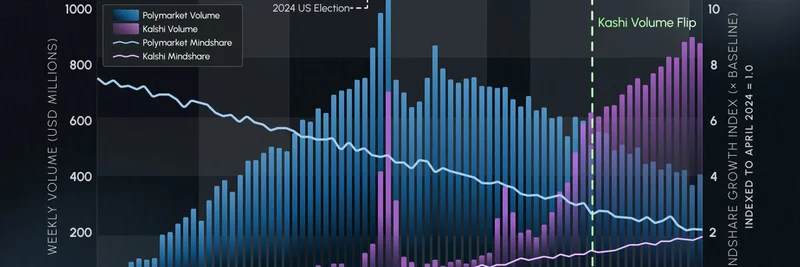In the fast-paced world of prediction markets, where bets on everything from elections to crypto trends can turn into big wins, two platforms have been duking it out for supremacy: Kalshi and Polymarket. A recent thread from Graeme (@gkisokay) on X breaks down this rivalry, highlighting how Kalshi has pulled ahead in trading volume by mastering the art of Crypto Twitter (CT) mindshare. Let's dive into what this means and why it's a game-changer for anyone in the blockchain space.
The Shift in Prediction Market Dynamics
Prediction markets let users bet on real-world outcomes, essentially crowdsourcing forecasts through financial incentives. Polymarket, long seen as the heavyweight, has focused on building deep liquidity and institutional ties. But Kalshi? They've flipped the script by turning CT into their secret weapon.
According to the thread, Kalshi's strategy kicked into high gear after hiring influencers like @j0hnwang and partnering with top key opinion leaders (KOLs) such as @beast_ico. This isn't just about endorsements—it's about creating a viral marketing flywheel. By aligning with CT personalities, Kalshi built narrative momentum and cultural buzz, which translated directly into user growth and trading activity.
For the first time, Kalshi's weekly notional volume surpassed Polymarket's, holding that lead for six straight weeks. That's no small feat in a market where volume is king.
Measuring Mindshare: The Growth Index Explained
What really stands out in Graeme's analysis is the "Mindshare Growth Index." This isn't your standard share-of-voice metric; it's all about velocity—the rate at which attention compounds over time. The chart in the thread compares weekly volumes (those bar graphs) with mindshare lines for both platforms since early 2024.
Polymarket still holds the lion's share of total attention, but Kalshi's index is skyrocketing, especially from Q3 onward. This exponential growth in mindshare mirrors their volume surge, suggesting that social buzz isn't just hype—it's a tangible driver of liquidity. In simple terms, more people talking about Kalshi on CT means more traders jumping in, creating a self-reinforcing loop.
Polymarket's Counterplay: Institutional Muscle
Polymarket isn't sitting idle. They've responded by signing big CT names like @waleswoosh and @LilMoonLambo, and they're gearing up for an official partnership with X (formerly Twitter) for broader distribution. But their real edge? Capital and scale.
The thread points to breaking news from the Wall Street Journal (though specifics aren't linked, it's referenced as NYSE's owner ICE eyeing a $2B investment in Polymarket at a $9B valuation). This kind of institutional backing screams legitimacy, positioning Polymarket as the go-to for mass adoption and deep-pocketed liquidity.
Contrasting Strategies: Attention vs. Capital
At its core, this battle boils down to two playbooks:
- Kalshi's Approach: Meme-driven mindshare fuels CT-led growth, attracting retail traders through viral narratives.
- Polymarket's Approach: Institutional legitimacy builds deep liquidity, paving the way for widespread adoption.
Graeme nails it: The winner will be whoever blends liquidity, attention, and distribution into one unstoppable force. In the attention economy, where blockchain meets social media, this fusion could redefine how we value information and culture.
Why This Matters for Meme Tokens and Blockchain Enthusiasts
While prediction markets aren't strictly meme tokens, the parallels are clear. Meme coins thrive on community hype and social momentum—much like Kalshi's CT strategy. If you're building or trading in the meme space, watching how platforms leverage influencers could inspire your next move. Plus, with tools like Kaito AI and Cookie.fun providing data insights (as mentioned in the disclaimer), staying data-driven is key.
The thread sparked some engaging replies too, from debates on liquidity's role to questions about sustainable flow beyond viral spikes. It's a reminder that in crypto, narratives evolve fast, and adaptability wins.
If you're into prediction markets, check out Kalshi or Polymarket directly to see the action firsthand. And remember, always DYOR—this isn't financial advice, just a peek into the evolving blockchain landscape.



